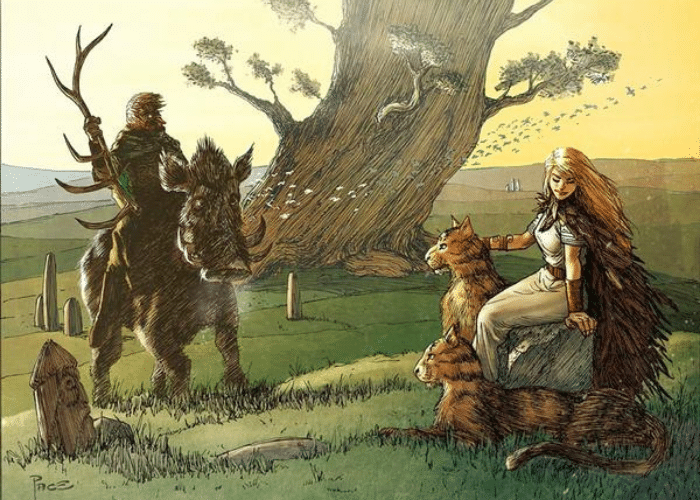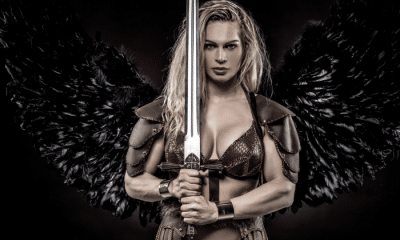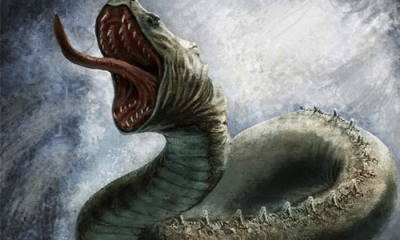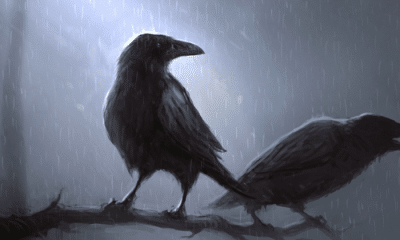
Norse
The Vanir Gods and Goddesses
The Vanir Gods and Goddesses
The Norse myths might feature Odin and his family, but did you know there was another group of gods altogether? Keep reading to find out about the Vanir pantheon and why they were so important!
Most of the well-known stories of Norse mythology focus on a group of gods known as the Aesir. Led by Odin, they were the residents of Asgard.
The Norse people, however, believed that there was another race of gods altogether. The Vanir were as powerful and venerated as the Aesir, although they appear in fewer stories.
The Vanir deities who do feature in myths are largely those who were adopted into the Asgardian pantheon. Although they lived among the Aesir, the Norse people recognized that they were of a different type.
So how did the people of the Viking Age end up with two unique pantheons, and what made the Vanir important in Norse culture?
The Vanir and Other Gods
The Norse people believed there were two groups of gods – the Vanir and the Aesir.
The Aesir are the most well-known of the Norse gods. Their chief, Odin, was considered the head of all the gods, and his sons, specifically Thor and Baldur, were among the most renowned deities in the pantheon.
In contrast, the Vanir are much less well-attested. Even the Old Norse word for the gods, asa, refers specifically to the Aesir.
Both legend and historical evidence, however, suggests that the Vanir were powerful and popular in their own right. While they are not as well-known from the poems and sagas of the era, their cults may have been just as strong as those of the Aesir.
There are many theories as to why the Vanir are less often written about than the Aesir. Their different functions, origins, and fates may have made them better suited to individual worship than more dramatic stories.
The War Between the Gods
One of the best pieces of evidence for the importance of the Vanir gods in Norse culture comes from the story of how the two pantheons came to be.
According to legend, the Aesir and Vanir had once been entirely separated. Although the Aesir became the more dominant pantheon, the Vanir were originally much more popular.
One of the reasons given for conflict between the two groups was that the Vanir were much more loved by the people. They received a greater number of sacrifices and offerings because they were more popular.
The two sides went to war against one another and were fairly evenly matched. Although the Aesir are generally considered the more war-like group, the Vanir were skilled in battle, too.
In the end, the two sides came to a truce. They exchanged members as a sign of their peace.
Njord went to live among the Aesir, along with his children Freyr and Freya. Although they were Vanir gods, they were also counted among the asas because they lived in Asgard.
Hoenir and Mimir were sent to live in Vanaheim, the home of the Vanir. Their reception was less warm, however.
Hoenir was handsome and strong, so he was immediately recognized as a leader. The Vanir chose him to replace Njord as their chief.
Mimir, meanwhile, was the god of wisdom. He became Hoenir’s chief advisor.
When he and Hoenir were alone in their conferences, he gave sage and thoughtful advice. In company, however, whenever Hoenir asked him what to do he replied that the best course was to ask someone else.
Not realizing the Mimir was accurately commenting on Hoenir’s ability to make decisions, the Vanir believed that they had been cheated and the god of wisdom was not as honorable as they had been told. They beheaded Mimir and sent his head back to Odin.
Freya used her magic to help Odin preserve and reanimate Mimir’s head. The disembodied god continued to give Odin advice from beside a well at Yggdrasil’s root.
As part of the truce, the two groups also agreed to be equals. They would receive the same share of honor and sacrifices from their human worshippers.
While the Aesir were more well-attested in written texts, however, the story claims that they were worshiped in equal measure. According to the written legends, the Vanir got the same amount of sacrifices as the Aesir even if they were not as prominent in the stories.
Magic Among the Vanir
According to many interpretations, the Vanir were able to hold their own in the war between the gods because they possessed knowledge of magic.
Although it is never stated clearly, legends seem to imply that the Aesir had no knowledge of seidr magic before the end of the gods’ war.
Freya is usually credited with teaching the Aesir about seidr, although her brother and father were said to have skill in it as well. Many times, all the Vanir were said to have skills in this fate-based form of magic.
Then said Heimdall, of Æsir brightest—he well foresaw, like other Vanir—”Let us clothe Thor with bridal raiment, let him have the famed Brisinga necklace.
-Poetic Edda, Þrymskviða (trans Thorpe)
In the description of the Aesir-Vanir War, it was said that the Vanir gods were wise in the ways of battle. The word wise was often used to refer specifically to magical knowledge.
It seems likely that this magic put the Vanir on equal footing with the Aesir, who were usually described as more skilled and stronger in war.
The Vanir magic was powerful enough that they were able to cause significant damage to Asgard itself. The story of how the magical horse Sleipnir was born centers around the need to rebuild Asgard’s damaged walls after the war.
Most historians interpret the Aesir as having more physical abilities, citing for example the strength of characters like Thor, while the Vanir focused on more magical and mysterious powers.
The Vanir soon introduced their abilities to the Aesir gods, however. While most of the Aesir still displayed little use of seidr, some became masters of it.
Frigg was sometimes said to have foresight and the ability to influence fate, both aspects of seidr. This is one of the reasons that she and Freya are occasionally seen as two aspects of the same being.
The greatest practitioner of seidr, however, was Odin.
While he was seemingly introduced to the Vanir’s form of magic by Freya, he soon became immensely knowledgeable. He famously made many sacrifices, including giving up an eye and hanging himself from the World Tree for nine days and nights, to learn more about fate and magic.
The Known Gods
Norse texts do not always make it clear which group of gods any individual belonged to.
Heimdall, for example, is described as an Aesir god who had great knowledge “like all the Vanir.” In a single passage, he is linked with both groups.
Identification is even more difficult for the goddesses.
Female deities were collectively referred to as the asynjur. Like the word asa, this is related to the Aesir but does not describe them uniquely.
The asynjur included not only both Aesir and Vanir goddesses, but also jotnar and elves. Even some human women among the Valkyries were grouped in with the asynjur.
The classification between the gods seemed to have been based as much on where they lived and who they associated with as their family of birth. Thus, while Freyr was undeniably a Vanir god he was named among the gods of Asgard.
Because the distinction was not always clear, modern historians have had to devise their own list of the Vanir gods. A few are named outright in Norse texts, but many are assumed to be Vanir based on their powers and the other gods they’re associated with.
The probable Vanir gods are:
- Njord (Njörðr) – The one-time leader of the Vanir joined the Asgardians at the end of the Aesir-Vanir War. Because of this, he was often counted among the Aesir.
- Freyr – Njord’s son was likewise a Vanir god who was adopted into the Aesir pantheon. He was regarded as one of the most noble and kind gods.
- Freyja – The daughter of Njord and sister of Freyr, she was a goddess of beauty and femininity. She is often credited with introducing magic to the Aesir.
- Hoenir – Originally one of the Aesir, he was immediately made the chief of the Vanir when he arrived at Vanaheim because of his strength and attractiveness.
- Heimdall – The god’s connection is dependent on translation. Some modern texts claim that he had powers similar to the Vanir while others claim that he was one of them.
- Gersemi – This rarely-attested goddess was the daughter of Freyja. Her name means “something of value.”
- Hnoss – A daughter of Freyja and Óðr, some historians believe she was the same as Gersemi. One poem, however, names both goddesses separately.
- Njord’s sister – This unnamed goddess was also the mother of Freyr and Freyja. The relationship is alluded to several times, but she is never identified.
- Gullveig – One poem claims that the war between the Aesir and Vanir began with an attack on Gullveig when she visited Asgard. Also called Heiðr, she is never mentioned again.
- Mímir – He was briefly sent to Vanaheim at the end of the war, but was beheaded by the Vanir and returned to Odin. Because he lived with both groups, he is sometimes counted among both.
- Kvasir – Born of the mixed spittle of both groups of gods, he was given to Asgard in the truce between the gods. This implies that he was counted among the Vanir, although it is never said directly.
The Vanir’s Powers
The Vanir supposedly had great control over magic, but this does not explain why they were so popular among the people. Knowledge of fate alone would not account for the preference shown to them.
Instead, the Vanir were well-loved among the Norse people because of the domains that fell under their purview.
Unlike some other religions, the Norse gods did not always have distinct domains. Most had vague and overlapping spheres of influence.
Thus, while Odin was a warrior god he also shared this domain with many other Aesir gods. Njord was sometimes associated with the sea, but so was Aegir and his wife Ran.
While many deities had similar domains, there was a much starker divide between the Aesir and the Vanir. Odin’s knowledge of seidr bridged this divide, but generally the Aesir were gods of might while the Vanir represented prosperity, fertility, and peace.
The most well-attested Vanir gods were Njord and his children, Freyr and Freya. All three were prayed to for prosperity.
Both Freyr and Freya were associated with fertility and beauty. All three gods were thought to ensure a good harvest and bring peace.
Njord was often linked to the sea. In the story of his marriage to Skadi, for example, he lived by the coast and loved the sound of gulls and waves.
Aegir, however, was the god of shipwrecks and drowning. Njord is interpreted as the god who brought bounty to fishermen and guided ships filled with gold and loot across the sea.
The Vanir were popular because they had control over the affairs of fate that concerned the common people.
While the Aesir were models for the nobility who focused on fighting prowess and riches, the Vanir appear to have been more earth-based gods. They made the land fertile, provided food, and watched over the young and weak.
This made them popular among the common people who farmed and fished for a living. They did not take part in the raids the Viking Age was known for, but they benefited from peace in their own land, fair weather, and the wealth that made its way into their own communities.
Uniquely Scandinavian Deities
The fact that the Norse people had two distinct pantheons of gods has long been intriguing to historians.
The Aesir gods have clear counterparts in other Germanic cultures. In some cases, such as the Germanic Wodan, the differences between continental and Scandinavian gods are negligible.
The Vanir, however, seem to have no clear similarities to any gods found outside of Scandinavia. While a few possible links have been made to Irish and Celtic gods, most evidence seems to show that the Vanir are native to the region.
Interestingly, however, they also do not seem to be immediately related to the gods of the indigenous Sami people of Northern Scandinavia. Although the Sami lived in the region before the first Germanic people moved there, the populations appear to have remained isolated enough for the religions to have had little influence on one another.
Instead, many historians believe that the Vanir gods provide evidence for a third group of Scandinavians. They believe that the story of the Aesir-Vanir War describes how the interactions between this group and the earliest Germanic settlers may have played out.
The first Germanic-speaking people to move into Sweden and Norway brought their Aesir gods with them. Odin, Thor, and other well-known Indo-European deities were part of their religion.
When they arrived, they encountered an established culture. Unfortunately, because this period was also one of rapid climate change in the area, there is little archaeological evidence for this culture.
If the legend does reflect historical events, the two groups eventually ended up waging war against one another. The battle between the gods serves as an allegory for the conflict between the people who worshipped them.
While the two groups fought, the story implies that neither completely overtook the other.
Instead, the gods were traded and the religions combined. The Germanic Aesir gods took some of the more popular Vanir members, while some of their own seemingly lost influence.
The legend of the Aesir-Vanir War seems to indicate that the Norse pantheon was not entirely Germanic. When the Aesir gods were brought from Central Europe, they combined with the uniquely Scandinavian gods to create a new religious system found in the Norse world alone.
The Vanir Pantheon
According to Norse mythology, there were two distinct groups of gods.
The Aesir, led by Odin, are more prominent in most myths so they are the most well-known today. The Vanir, however, were seen as just as powerful and important.
Norse legends said that the two pantheons had fought one another early in their history. As part of the truce between them, the most prominent Vanir deities moved to Asgard.
These were Njord, Freyr, and Freya, who were among the only gods definitively named as Vanir in contemporary sources. Although they lived among the Aesir, their powers and domains were different.
The Vanir appear to have been generally linked to concepts of fertility, prosperity, and good fortune. This marked them apart from the Aesir gods, who primarily represented physical strength.
These domains made the Vanir especially important to common people, the farmers and laborers of Scandinavia. While the Aesir represented the lofty positions of the upper classes, the Vanir’s influence over fertility and bounty made them favorites of the commoners.
The Vanir were also linked to seidr, a type of shamanistic magic that was concerned with fate and foretelling the future. Legends suggest that the Aesir, including Odin who became a master mage, knew nothing of seidr before they were taught by Freya.
The Vanir gods appear to have been entirely native to Scandinavia. Unlike the Aesir, there are no obvious parallels between them and the gods of other Germanic cultures.
Historians believe that this is likely because they belonged to an indigenous group that predated the arrival of Germanic people in the Bronze Age. The legend of the Aesir-Vanir War could be an allegorical tale of how these two groups clashed before eventually blending to create a unique Norse religion.









